Annunciation (Memling)
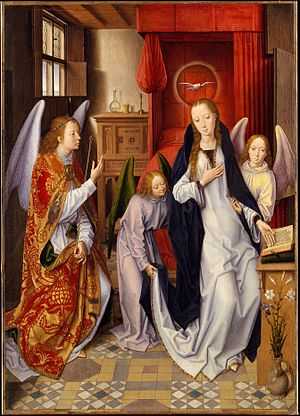
The Annunciation by Hans Memling is an Early Netherlandish oil-on-oak painting, partially transferred to canvas, measuring 30 1/8 x 21 1/2 in. (76.5 x 54.6 cm). It is held in the Robert Lehman collection at the Metropolitan Museum of Art, in New York. Executed c. 1482 (or c. 1489), it depicts the Virgin in a domestic interior with two attendant angels at her side and archangel Gabriel, who is dressed in rich ecclesiastical robes. The dove of the Holy Spirit hovers above her head.[1]
The painting is based on the Saint Columba Altarpiece's left wing, by Rogier van der Weyden, but Memling goes beyond mere imitation. The Virgin in rendered in a highly unusual position in which she appears to be simultaneously kneeling and swooning. The swoon hearkens to the future and Christ's death. The iconography refers directly to the Virgin's purity.[1]
The painting's frame survived until the 19th century and was believed to be inscribed with a date of 1482. More recent research suggests the number's final digit is a nine, making the execution date 1489. Generally scholars are inclined to believe the 1489 date to be more in keeping with Memling's more mature style of the late 1480s.[1]
Description
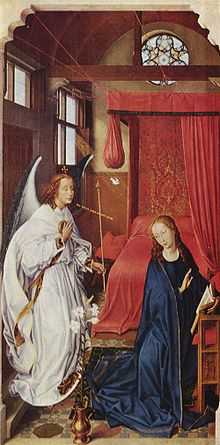
In European art the Annunciation was a popular theme.[2] By the 15th century Early Netherlandish painters typically placed it event in a domestic interior, a style established by Robert Campin, Jan van Eyck and Rogier van der Weyden.[3] The Virgin in a bedchamber, called thalamus Virginis, was derived from contemporary illustrated miniatures, such as the poplar "Birth of St. John", and is first seen in panel painting in van der Weyden's Columba Altarpiece.[4] Memling's Annunication is a near-identical version of the same scene,[5] as it became more common to show the Virgin standing by the nuptial bed, which was typically rendered in red made from costly pigments.[4]
The archangel Gabriel appears in Mary's bed-chamber, informing her she shall bear the son of God,[6] He stands in a three-quarters view,[7] a small diadem on his head, dressed in vestments. Beneath a red and gold brocade cope, edged with a pattern of gray seraphim and wheels is a white alb and amice.[8] The staff of office is in one hand, while the other is raised to her;[8] his knees are bent, honoring and acknowledging her status as Mother of Christ and Queen of Heaven,[3] feet bare and positioned slightly behind hers.[9] An sense of movement, the moment of arrival, is apparent by the trailing edges of his garment left outside the pictorial space.[10]
The Virgin is shown in a frontal view,[7] the red-curtained bed behind framing her in the traditional canopy of honor or (baldachin).[4] Unlike his predecessors whose Virgins are garbed in robes of costly fabrics and heavily jeweled, Memling's Virgin is dressed in a plain white dress, minimally jeweled at the neckline, where a purple underdress peeks out as an indication of her royal status.[11]
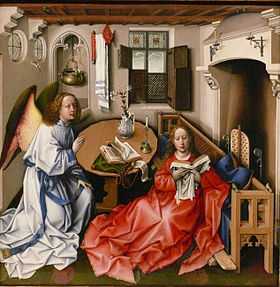
Her position is unusual, balancing between rising or swooning, which diverges from the convention of either seated or kneeling. The pose is innovative, according to Blum who write, "One may search in vain in other Netherlandish Annunciation panels of the fifteenth century of a virgin positioned as she is here".[4] She is flanked by two attendant angels. On her left an angel lifts her robe, while the one to the right gazes at the viewer, "soliciting our response", according to Ainsworth.[3] They are small in stature, solemn and according to Blum, in mood "comparable to that of Gabriel."[12]
Within a circle of light, the dove of the Holy Spirit hovers directly above her head. Its placement and size is unusual for art of the period, unlike anything similar found in van der Weyden and never repeated in Memling's work but reminiscent of van Eyck's dove in the Ghent altarpieces Annunciation panel.[8] It is similar to medallions hung above beds at that time, and thus seems in keeping with the domestic interior.[13]
She holds her left hand on a prayer book placed on a prie-dieu, on which the letter "D" is visible –perhaps for Deus tecum ("the Lord be with you), according to Ainsworth.[3] Blum speculates the passage is from Isaiah 7:14, "Behold a Virgin shall conceive and bear a son."[9] A vase with white lilies and a single blue iris on the floor besides the prie-dieu.[14]
In the central axis, between Gabriel and the attendant angel, hangs a curtain sack, or "hung bed", commonly found in bedchambers of the period.[15] To the left of the bed is a cabinet, onto which light shines from the a window on the wall. A flask of water and two types of candles are arranged on the cabinet.[3] The flooring is of multi-colored tile-work, similar to van der Weyden's Columba altarpiece, but Memling's scene truncates the ceiling rafters in the mid-ground, at the end of the bed, with the floor extending into foreground. The effect "acts like an open stage for the holy figures", explains Blum. [7]
Iconography
The Annunciation was a delicate and difficult scene to paint, according to Shirley Neilsen Blum. It must depict the Virgin Mary's union with Christ, while showing her as tabernacle and flesh made real. Mary as Theotokos, the God-bearer, was affirmed in 431 at the Council of Ephesus. Two decades later the Council of Chalcedon affirmed the doctrine of Incarnation – that Christ was of two natures (God and Man) – and Mary's perpetual virginity was affirmed at the Lateran Council of 631. In Byzantine art the Annunciation depicts the Virgin enthroned, dressed in royal regalia,[13] but in later centuries she is often shown in enclosed spaces; the temple, the church, the garden.[11]
The iconography in Memling's Annunciation is uncomplicated and obvious; extraneous symbolism is eliminated.[9] The meaning of the symbols point directly at Mary's role as Mother of God.[6] He renders the scene with naturalism to the point that the "immediacy of the announcement" is not apparent. Mary seems neither surprised nor fearful; but according to Blum he successfully depicts "the transformation of Mary from girl to God-bearer."[9] The chamber is furnished with apparently ordinary objects, yet they are infused with religious symbolism, signifying the Virgin's purity.[6] The vase with the lilies and the sideboard with the carafe and candlestick are symbols viewers would have recognized as iconography commonly associated with Mary.[6]
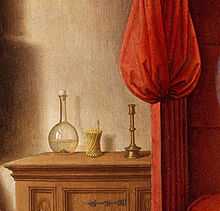
The Virgin's purity is represented by the three objects on the bedside cabinet, the water flask, the candleholder – without a candle – and the ropewick light. The flask's water remains clear and undisturbed with light flowing through, just as the Virgin retains her purity at the moment of conception.[3] A flask of clear water was a conventional symbol of the Virgin's purity, found in van Eyck's Ghent Altarpiece Annunciation panel and numerous others, to indicate that just as the light pierces the glass, leaving it undisturbed, so the divine light pierced the Virgin's flesh, leaving it pure. Typically in Netherlandish art the concept of Christ "who inhabited and passed through her body" is additionally indicated by rays of light representing the Incarnation emanating from Gabriel or a window, which enter Mary's body, or by an inscription placed along a ray of light. Barely visible on the side of this flask is the reflection of the window's crossbars, showing as a cross on the flask, looking forward to Christ's crucifixion, a small detail in which Memling "lays one translucent symbolic form upon another".[16]
Likewise, the candles are symbols conventionally associated with the Virgin and Christ. The lights are extinguished here; the ropewick is without a flame, the candleholder without a candle, because they presage the moment of Christ's birth and the coming of his divine light.[3] Yet, light was equally a symbol conventionally attached to Mary. The room with its window through which light streams is a most "decorous sign of Mary's chastity", according to Blum.[17] Similar to Dieric Bouts' Getty Annunication, the rays of light are missing here, yet the room is bright, filled with sunlight, a fenestra incarnationis, which would have been an adequate symbol for the contemporary viewer.[17] Similarly the word scrolls, or banderoles are missing, in which the Virgin's acceptance is indicated, yet her consent is obvious through the pose, which is "at once submissive and active", according to Charles Sterling.[18]
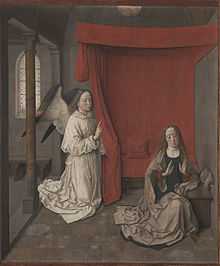
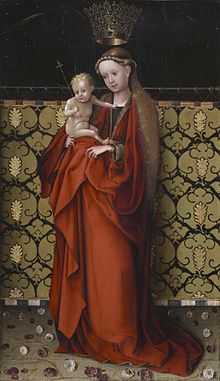
The scene, additionally, represents the Virgin as a woman who gave birth to a child, indicated by the bed and the womb-shaped curtain-sack, which hangs prominently in the central axis of the pictorial space. The hung bed or curtain sack became a symbol of the incarnation by the early 15th century, signifying that Christ was formed in the Virgin's womb and thereby "served to affirm [his] humanity". Blum writes that at a time "when artists did not hesitate to depict the breast of the Virgin, Memling did not shun her womb". [15]
The incarnation is a moment of transubstantiation; Mary's body is the tabernacle holding the host made flesh.[8] She is an object of devotion, representing a "monstrance containing the Host", writes Ainsworth.[3] Viewers would have been reminded of the Crucifixion and Lamentation with the swoon, "thus anticipating Christ's sacrifice for the salvation of mankind at the moment of his conception."[3] Her swollen belly and the presence of the dove above indicate the moment of incarnation has occurred.[3] The dove's shape would have reminded the viewers of the eucharist and Mass. Lotte Brand Philip discovered that during the 15th century such "eucharistic vessels made in the form of doves and suspended over altars … were lowered at the moment of transubstantiation", and here reminds that as the Holy Spirit gives life to the bread and wine, it gave life to the Virgin's womb.[8]
At this moment in the narrative, the Virgin is the Bride of Christ and she will become the Queen of Heaven. The two attendant angels indicate her royal status.[11] The angels in this painting are exceptional in Northern art, according to Sterling. Attendant angels are commonly found floating above the Virgin, holding her crown, and some German painters showed them in Annunciation scenes, hovering close, but never do we see angels approach or touch the Virgin.[19] Although Memling often showed a pair of angels attending the Virgin, dressed in vestments, these two, dressed in a simple amice and alb, were not to be repeated in his art. They have a dual function, to "present the eucharistic offering and proclaim the Virgin bride and queen".[11]
Provenance and condition
The painting's provenance can be dated to the 1830s when it was in the possession of the Radziwill family who kept it until 1920 when Princess Radziwill sold it the Duveen Brothers in Paris. Philip Lehman bought it in October 1920.[3]
Generally the condition is good. There have been three documented restorations; the first in 1830, the second after its exhibition in Bruges in 1902; and the third when Lehman had it restored and transferred to canvas.[20]
References
- ↑ 1.0 1.1 1.2 "The Annunciation". Metropolitan Museum of Art. Retrieved April 19, 2015.
- ↑ "The Annunciation". Metropolitan Museum of Art. Retrieved April 28, 2015.
- ↑ 3.0 3.1 3.2 3.3 3.4 3.5 3.6 3.7 3.8 3.9 3.10 Ainsworth (1998), 118
- ↑ 4.0 4.1 4.2 4.3 Blum (1992), 43
- ↑ Snyder (1987), 38
- ↑ 6.0 6.1 6.2 6.3 Kathleen (2000), 353
- ↑ 7.0 7.1 7.2 Blum (1992), 55
- ↑ 8.0 8.1 8.2 8.3 8.4 Blum (1992), 49
- ↑ 9.0 9.1 9.2 9.3 Blum (1992), 50
- ↑ Sterling (1998), 80
- ↑ 11.0 11.1 11.2 11.3 Blum (1992), 53
- ↑ Blum (1992), 54
- ↑ 13.0 13.1 Blum (1992), 52
- ↑ Blum (1992), 48
- ↑ 15.0 15.1 Blum (1992), 44
- ↑ Blum (1992), 46
- ↑ 17.0 17.1 Blum (1992), 47
- ↑ Sterling (1998), 83
- ↑ Sterling (1998), 82
- ↑ Sterling (1998), 78
Sources
- Ainsworth, Maryan. "Hans Memling: The Annunciation". In: From Van Eyck to Bruegel: Early Netherlandish Painting in the Metropolitan Museum of Art. New York: Metropolitan Museum of Art, 1998. ISBN 0-87099-870-6
- Blum, Shirley Neilsen. Hans Memling's 'Annuciation' with Angelic Attendants". Metropolitan Museum of Art Journal. Vol 27, 1992
- Howard, Kathleen (ed). The Metropolitan Museum of Art Guide. New York: Metropolitan Museum of Art, 2000. ISBN 0-87099-711-4
- Jolly, Penny Howell. PIcturing the 'Pregnant' Magdalene in Northern Art, 1430-1550: Addressing and Undressing the Sinner-Saint. Farnham, Surrey: Ashgate, 2014. ISBN 978-1-4724-1495-3
- Snyder, James (ed). The Renaissance in the North. New York: Metropolitan Museum of Art, 1987. ISBN 978-0-87099-434-0
- Sterling, Charles. Fifteenth- to Eighteenth-century European Paintings in the Robert Lehman Collection. New York: Metropolitan Museum of Art with Princeton University Press, 1998. ISBN 0-691-00698-9
| ||||||||
_-_WGA07678.jpg)
